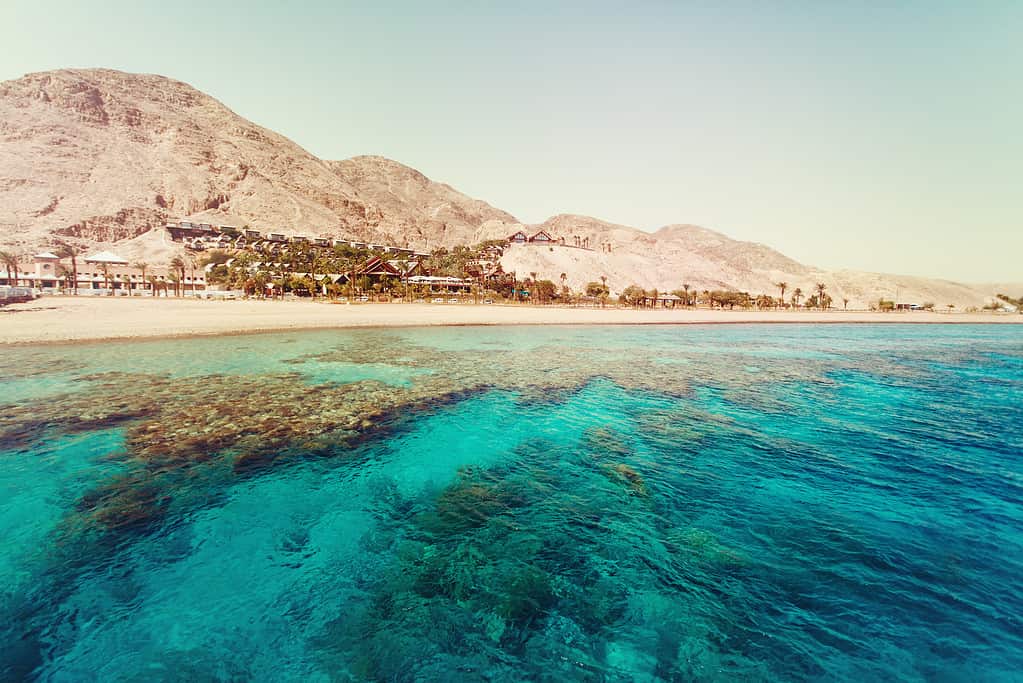It sometimes wears a reddish hue but only when the conditions are just right. It’s long been used by ships for trade and commerce and today, snorkelers and scuba divers from around the world visit to explore its underwater paradise. Learn what lives at the bottom of the Red Sea!
What is the Red Sea?
The Red Sea, bordered by Sudan, Egypt, and the Arabian Peninsula is a body of saltwater known for its unique features, biodiversity, and geography. It’s a popular tourist destination with a rich history of both commerce and trade. The Red Sea is quite narrow and spans 1,400 miles. It’s a little over 200 miles wide.
Surrounding the sea are reddish-brown mountains, which is how the Red Sea acquired its name. The water is typically blue, but sometimes it reflects a reddish hue when there are specific phytoplankton and algae present. The Red Sea’s biodiversity is impressive, and many different marine organisms call its waters home (including coral reefs and a wide range of fish).
Despite its high salinity, it’s crowded with marine life and features a unique ecosystem. The Red Sea continues to be a popular location that calls forth tourists looking to snorkel or scuba dive. There’s plenty to explore underwater and there’s a lot to learn about its history since ancient civilizations used it for trade between the Indian Ocean and the Mediterranean Sea.

The Red Sea is surrounded by reddish-brown mountains.
©Oleg_P/Shutterstock.com
Why is the Red Sea So Deep?
The Red Sea’s depth didn’t come about overnight. It has taken millions of years for the Red Sea to form into what it is today. A multitude of geological processes had to take place for the Red Sea to reach depths of well over 6,500 feet. For example, rifting has caused the Red Sea to widen over time and it sits next to a divergent boundary, which means that there are tectonic plates that continuously move in opposite directions.
When this occurs, the crust of the earth is altered, which leaves deep depressions that the water eventually fills. Along with the earth’s crust thinning and stretching, the mantle starts to rise, which causes the gaps to fill with magma. This is yet another contributor to the depths of the Red Sea. Ultimately, it’s the tectonic forces paired with the volcanic activity that has both elongated and deepened the Red Sea.
What Lives at the Bottom of the Red Sea?
Marine life thrives in the Red Sea and includes a variety of organisms like fish, corals, sponges, and worms. There are both soft and hard corals, which is why it’s such a popular destination for snorkeling and scuba diving. The fish you might encounter in the Red Sea include groupers, angelfish, and moray eels, among others.
There are mollusks like oysters and clams and there are also octopuses and cuttlefish. There’s a variety of worms that burrow into the Red Sea‘s floor and a wide range of invertebrates like surgeons, sea stars, and cucumbers. You can find sea turtles and seahorses among all the microorganisms that call the Red Sea home as well.

There are both soft and hard corals in the Red Sea.
©iStock.com/vlad61
Rare Animals of the Red Sea
Sea turtles, particularly hawksbill and green sea turtles are two of the rare and endangered marine turtles in the Red Sea. There are also Red Sea clownfish, Red Sea sailfish, and Red Sea walkmans, which are venomous devilfish. The oceanic white-tip shark doesn’t just reside in the Red Sea, but it is a rare species that enjoys the depths of the environment. There is the Arabian carpet flathead, which is native to the Red Sea. It’s not easy to spot considering its elusive nature.
What’s Wrong With the Red Sea?
The Red Sea continues to face several issues that threaten its natural environment. For example, with rising sea temperatures, there has been a loss of the coral reefs that line the Red Sea. Climate change along with pollution and oil spills all lead to habitat destruction. Conserving the Red Sea is a challenge as this process requires international coordination. Nevertheless, several countries like Egypt, Israel, Eritrea, Saudi Arabia, Yemen, and Sudan all work together to save the Red Sea’s marine life.

The Red Sea continues to face several issues that threaten its natural environment such as rising sea temperatures leading to a loss of the coral reefs.
©DariaZu/iStock via Getty Images
Interesting Facts
You know a bit about how the Red Sea has formed and the kinds of underwater creatures that inhabit it. But here are a few more fun facts about the Red Sea:
- The Red Sea has religious importance for a variety of faiths, including Christianity, Judaism, and Islam.
- Sometimes, the Red Sea goes by a different name: “Underwater Garden of Eden.”
- Though the Red Sea has impressively deep areas, about 40% is less than 330 feet deep.
- The coral reefs in the Red Sea are thousands of years old.
Thank you for reading! Have some feedback for us? Contact the AZ Animals editorial team.








